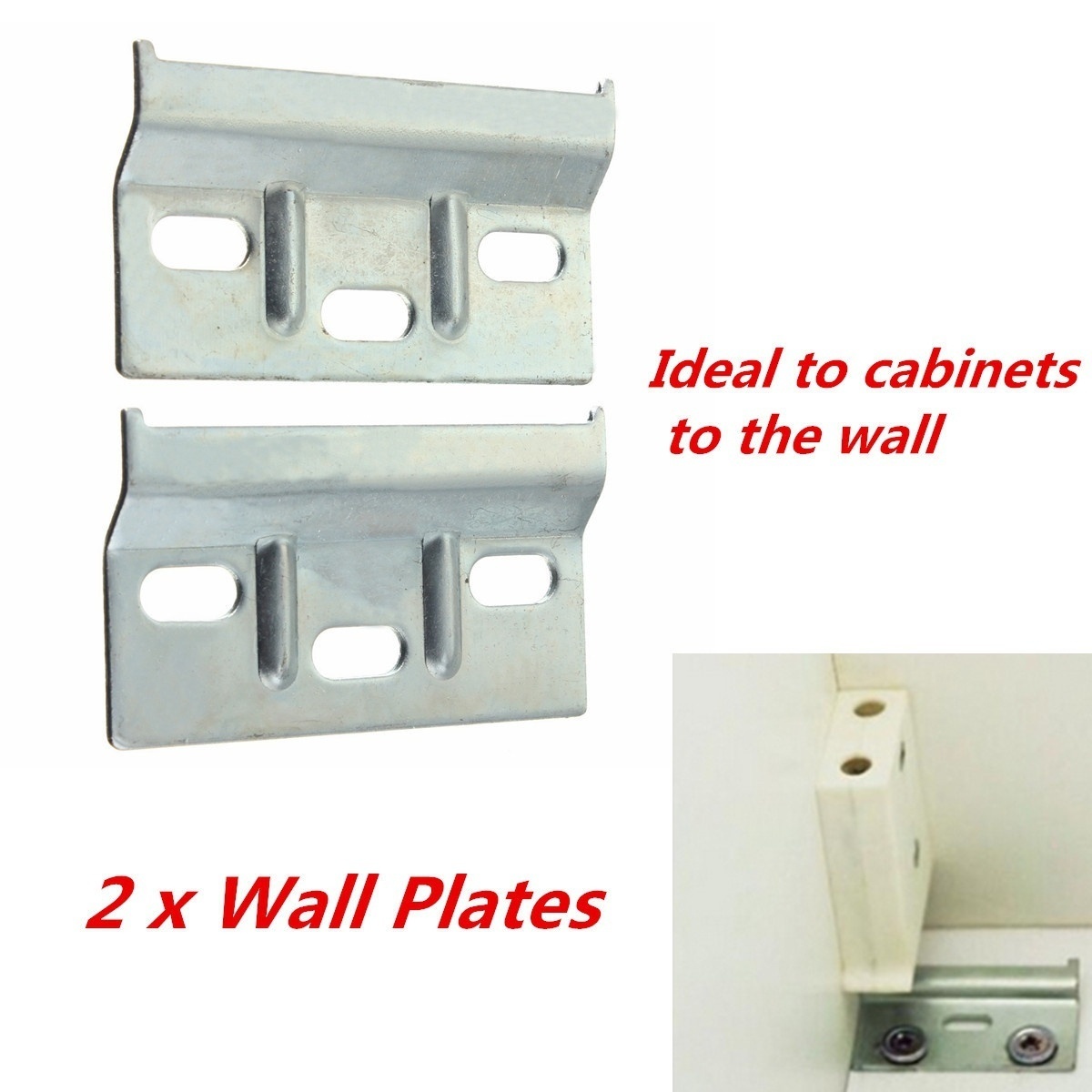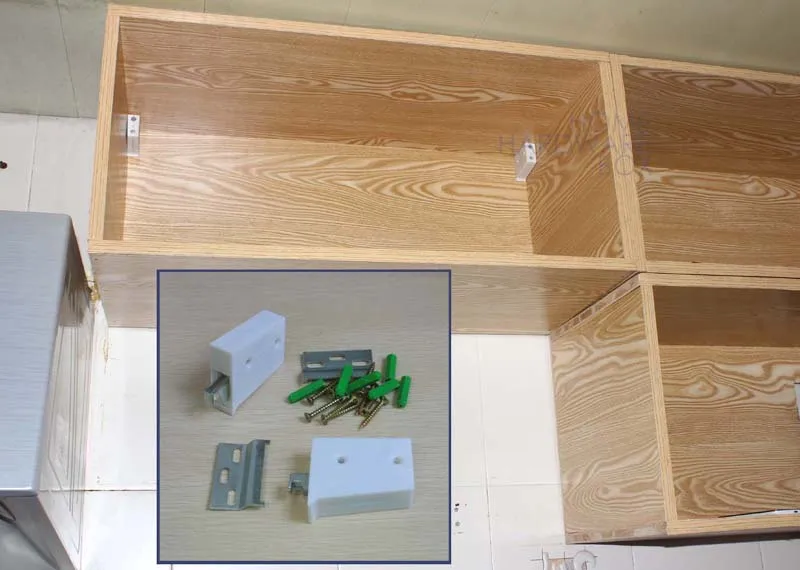Types of Kitchen Wall Cabinet Brackets

Kitchen wall cabinet brackets are essential components for supporting and securing your upper cabinets, ensuring stability and safety. They come in various types, each with unique features, materials, and installation methods. Choosing the right type depends on factors such as the cabinet’s weight, desired aesthetic, and your budget.
Types of Kitchen Wall Cabinet Brackets
Kitchen wall cabinet brackets are typically categorized into three main types: adjustable, fixed, and decorative.
Adjustable Brackets
Adjustable brackets are designed to accommodate slight variations in wall thickness or cabinet placement. They are highly versatile and can be adjusted to ensure a secure and level installation.
- Materials: Adjustable brackets are typically made of metal, such as steel or aluminum, offering strength and durability. Some brackets may also incorporate plastic components for added functionality.
- Load Capacity: Adjustable brackets can typically support a significant weight, ranging from 50 to 100 pounds per bracket, depending on the specific model and materials used.
- Installation Method: Adjustable brackets are usually installed with screws or bolts into the wall studs. They often feature a sliding mechanism that allows for precise adjustments to ensure proper alignment and stability.
Fixed Brackets
Fixed brackets are non-adjustable and provide a permanent, secure connection between the cabinet and the wall. They are typically used for cabinets with specific dimensions and placement requirements.
- Materials: Fixed brackets are commonly made of metal, such as steel or aluminum, offering strength and durability. Some brackets may also incorporate plastic components for added functionality.
- Load Capacity: Fixed brackets can typically support a significant weight, ranging from 50 to 100 pounds per bracket, depending on the specific model and materials used.
- Installation Method: Fixed brackets are usually installed with screws or bolts into the wall studs. They are designed to provide a secure and permanent connection, eliminating the need for adjustments.
Decorative Brackets
Decorative brackets are designed to enhance the aesthetic appeal of your kitchen cabinets. They are available in various styles and finishes, allowing you to choose options that complement your kitchen’s design.
- Materials: Decorative brackets are often made of metal, such as wrought iron, brass, or stainless steel, to provide both strength and a decorative element. Some brackets may also incorporate wood or other materials for a more rustic or contemporary look.
- Load Capacity: Decorative brackets can typically support a moderate weight, ranging from 25 to 50 pounds per bracket, depending on the specific model and materials used.
- Installation Method: Decorative brackets are usually installed with screws or bolts into the wall studs. They often feature decorative elements that add visual interest to your kitchen cabinets.
Comparison of Kitchen Wall Cabinet Brackets
The following table summarizes the advantages and disadvantages of each type of kitchen wall cabinet bracket:
| Type | Advantages | Disadvantages |
|---|---|---|
| Adjustable | Versatility, easy to adjust for uneven walls, allows for precise cabinet placement | May be more expensive than fixed brackets, can be more difficult to install |
| Fixed | Cost-effective, provide a permanent and secure connection, easy to install | Less versatile than adjustable brackets, require precise measurements for installation |
| Decorative | Enhance the aesthetic appeal of your kitchen, available in various styles and finishes | May not be as strong as adjustable or fixed brackets, can be more expensive |
Kitchen Wall Cabinet Bracket Specifications
The following table provides details about the materials, load capacity, and installation methods of different types of kitchen wall cabinet brackets:
| Type | Material | Load Capacity (lbs) | Installation Method |
|---|---|---|---|
| Adjustable | Steel, aluminum, plastic | 50-100 | Screws or bolts into wall studs |
| Fixed | Steel, aluminum, plastic | 50-100 | Screws or bolts into wall studs |
| Decorative | Wrought iron, brass, stainless steel, wood | 25-50 | Screws or bolts into wall studs |
Choosing the Right Kitchen Wall Cabinet Brackets

Choosing the right kitchen wall cabinet brackets is crucial for ensuring your cabinets are securely mounted and can handle the weight of their contents. This decision involves considering various factors, including the weight of the cabinets, the material of your walls, and your aesthetic preferences.
Determining the Appropriate Size and Load Capacity
The size and load capacity of the brackets are directly related to the weight of the cabinets they will support. To determine the appropriate size, you need to consider the weight of the cabinet, the material of the wall, and the number of brackets needed.
- Cabinet Weight: Measure the weight of the cabinet using a scale. If you’re unsure, you can estimate the weight based on the cabinet’s size and material.
- Wall Material: Different wall materials have varying load-bearing capacities. Drywall is less sturdy than concrete or brick, requiring heavier-duty brackets. Consult a professional for specific load-bearing information about your wall material.
- Number of Brackets: The number of brackets required depends on the cabinet’s size and weight. Larger, heavier cabinets need more brackets for support. A general rule of thumb is to use two brackets for cabinets up to 30 pounds, three for cabinets between 30 and 60 pounds, and four or more for heavier cabinets.
Choosing Brackets Based on Kitchen Style and Cabinet Design, Kitchen wall cabinet brackets
The style of your kitchen and cabinet design can influence your bracket selection.
- Traditional Kitchen: Consider ornate brackets with decorative flourishes to complement the classic aesthetic. Brackets made of brass, bronze, or wrought iron can enhance the traditional look.
- Modern Kitchen: Opt for minimalist brackets with clean lines and sleek finishes. Stainless steel, brushed nickel, or black powder-coated brackets are ideal for a modern kitchen.
- Contemporary Kitchen: Choose brackets with geometric shapes and bold colors. For a contemporary look, consider brackets made of acrylic, glass, or wood with unique designs.
Installing Kitchen Wall Cabinet Brackets

Installing kitchen wall cabinet brackets is a crucial step in ensuring your cabinets are securely mounted and function properly. Proper installation involves a few key steps, from measuring and marking to drilling and securing the brackets.
Tools and Materials
The right tools and materials are essential for a successful installation. Here’s what you’ll need:
- Drill: A cordless drill with a variety of drill bits, including a Phillips head bit for driving screws and a drill bit matching the size of the bracket’s mounting holes.
- Level: A level is crucial for ensuring your cabinets are installed straight and even.
- Tape Measure: A tape measure is necessary for accurate measurements of the cabinet and wall.
- Stud Finder: A stud finder helps locate the wall studs, which provide the most secure mounting points for the brackets.
- Pencil: Use a pencil to mark the drilling locations on the wall.
- Screws: Choose screws that are appropriate for the type of wall and the weight of the cabinet.
Step-by-Step Installation Process
The installation process involves a series of steps that ensure a secure and stable mounting for your kitchen cabinets.
- Measure and Mark:
- Measure the distance between the cabinet’s mounting holes.
- Using a level, mark the desired height for the cabinet on the wall.
- Transfer the measurement of the cabinet’s mounting holes to the wall, ensuring the markings are level.
- Locate Studs:
- Use a stud finder to locate the wall studs behind the marked locations. It’s crucial to mount the brackets into studs for maximum support.
- If the markings don’t align with studs, consider using toggle bolts or heavy-duty anchors for additional support.
- Drill Pilot Holes:
- At each marked location, drill pilot holes slightly smaller than the diameter of the screws you’ll be using. This prevents the wood from splitting when driving the screws.
- Use a drill bit that is slightly smaller than the diameter of the screws you’ll be using.
- Secure the Brackets:
- Align the brackets with the pilot holes, ensuring they are level and plumb.
- Drive the screws through the pilot holes into the brackets, securing them firmly to the wall.
- Use a screwdriver or drill with a Phillips head bit to drive the screws.
Important Considerations
Here are some important considerations for a successful installation:
- Ensure Proper Alignment: Use a level to ensure that the brackets are aligned properly before securing them to the wall. This will help prevent the cabinets from being crooked or uneven.
- Use the Right Screws: Choose screws that are long enough to reach through the bracket and into the wall stud. Use screws that are rated for the weight of the cabinet.
- Don’t Overtighten: Overtightening screws can damage the bracket or wall. Tighten the screws securely, but don’t force them.
Kitchen wall cabinet brackets are pretty handy, holding up all those dishes and spices. But if you’re feeling ambitious, why not build something bigger? You can use similar skills to build a sturdy wooden file cabinet, like in this guide , and keep all your important documents organized.
Plus, with a little creativity, you can even give it a custom look that matches your kitchen cabinets. Maybe you could even use some of those same brackets to hold the file cabinet in place!
Kitchen wall cabinet brackets are a must-have for anyone looking to maximize their kitchen space. They provide sturdy support for shelves and cabinets, allowing you to store everything from dishes and cookware to spices and snacks. If you’re looking for a more elegant storage solution for your living room, consider wooden storage cabinets for living room.
They can add a touch of warmth and sophistication while providing ample storage space for books, electronics, and decorative items. Regardless of your choice, the key is to ensure that the brackets you use are strong and durable enough to support the weight of your cabinets and their contents.
